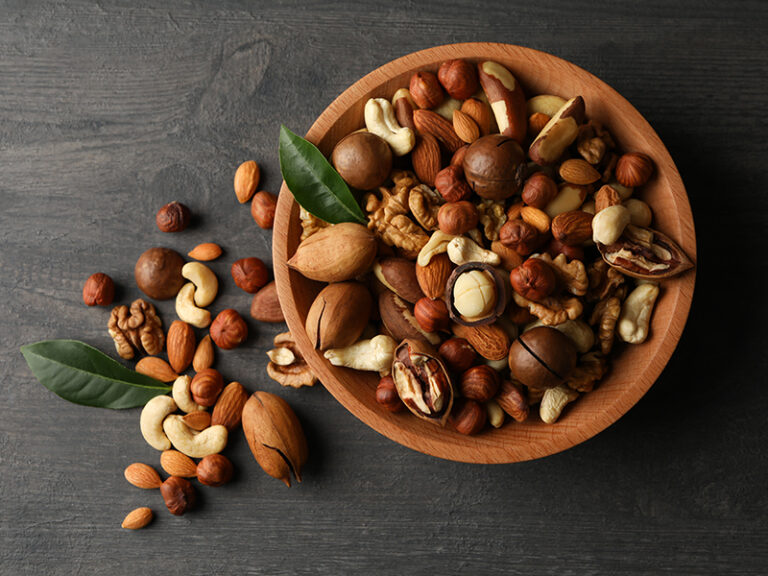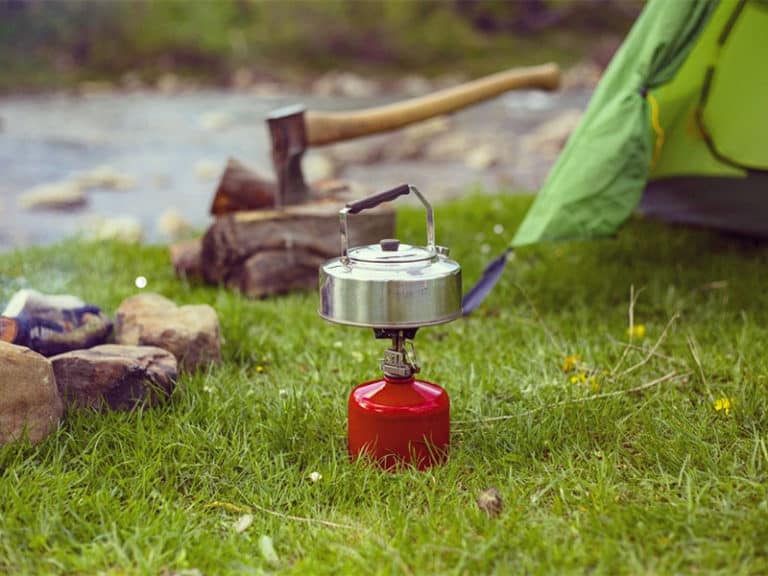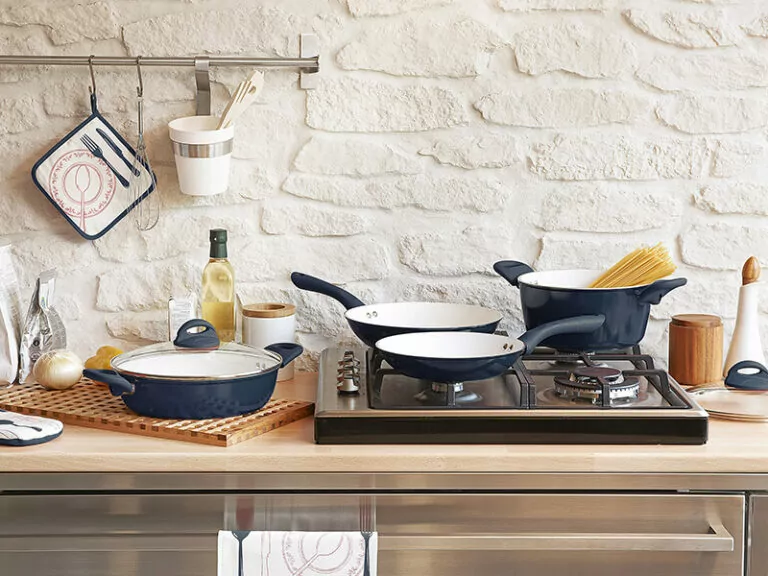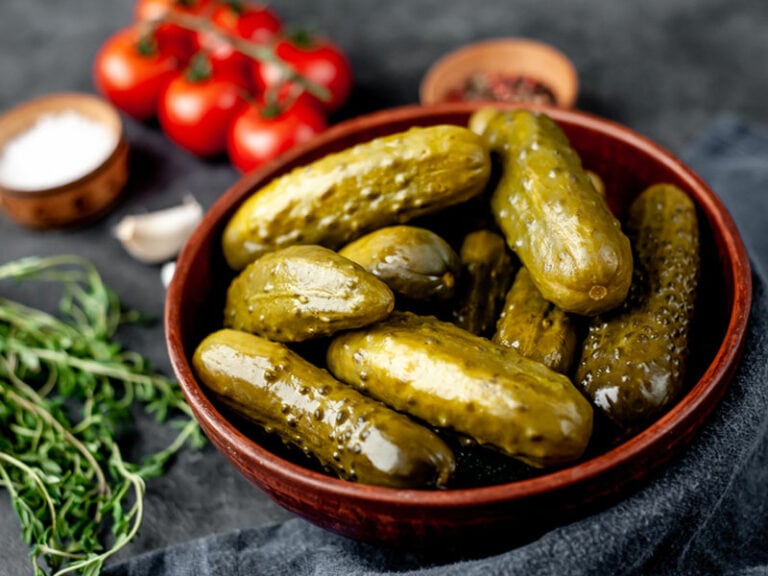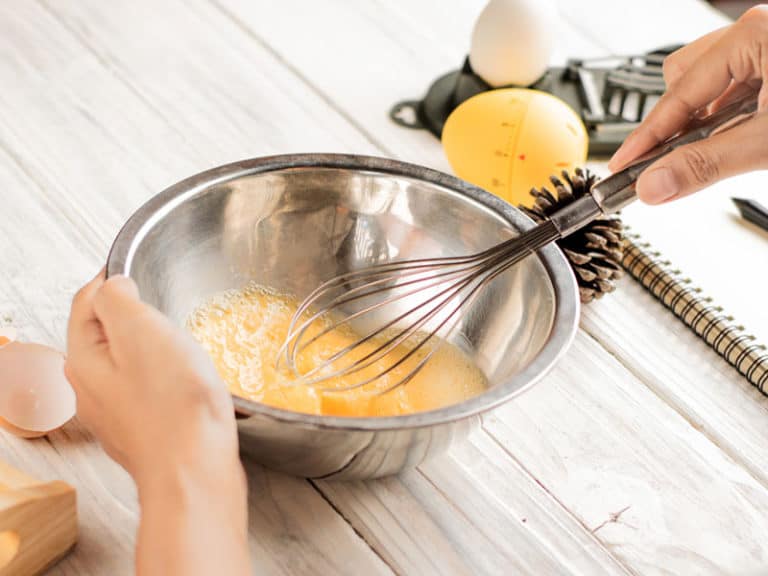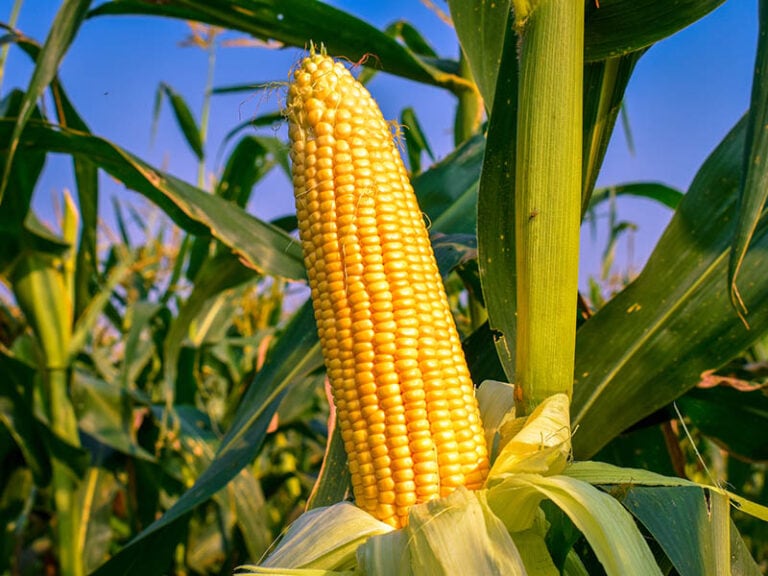Though cinnamon has been added to drinks practically forever, many people are still puzzled over the question: Does cinnamon dissolve? If you are one of those people, no biggie. In this post, I will provide all the answers you need about cinnamon.
Cinnamon is almost a fall season drink staple. Besides being used in drinks, it also appears in desserts, main course dishes, and snacks. Its versatility makes it a must-have spice in everybody’s kitchen.
But let’s not dawdle no further! Scroll down to learn everything you need to know about cinnamon.
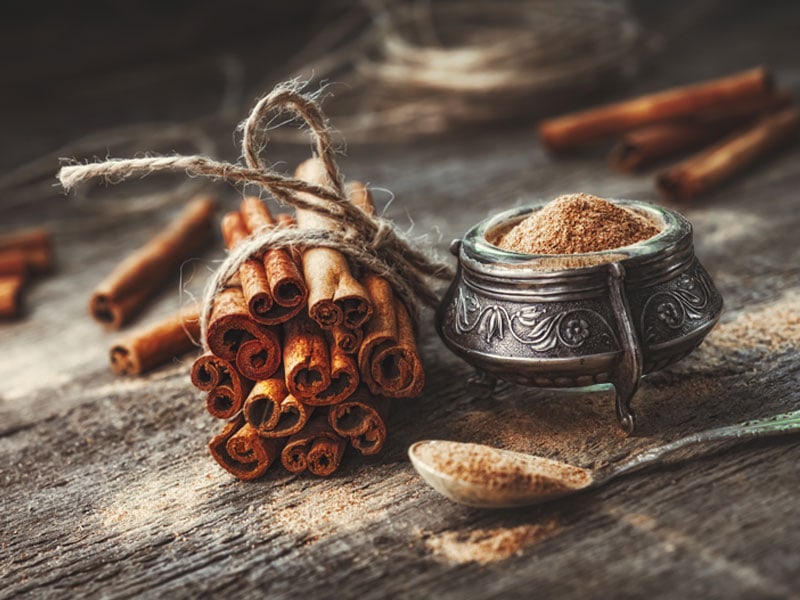
What Is Cinnamon?
To understand cinnamon, it’s best to start with the basics. In this section, I am going to introduce some simple information about cinnamon that you might not know yet.
How It’s Made
Cinnamon is, quite literally, barks of trees. They are harvested from cinnamon trees worldwide and go through a drying process before being rolled up into sticks or ground into fine powder.
Types Of Cinnamon
There are many species of cinnamon, but the general public only commonly consumes some of them. In the next part, I’m going to walk you through two popular types that are commercially sold and used. (1)
Cassia Cinnamon
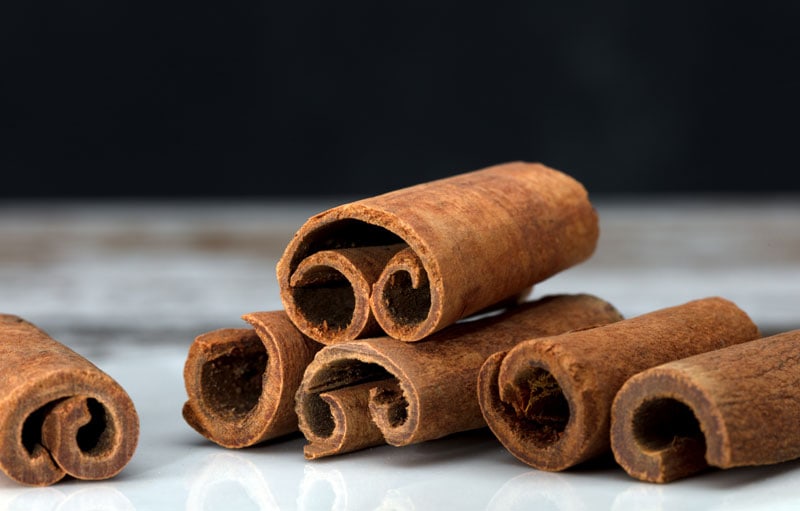
The first type of cinnamon, the Cassia cinnamon, is the more commonly used type. The trees originally grew in southern China, but cinnamon products are widely popular in Asia and the USA.
It usually has a dark brown color with a tinge of red, and its flavor packs a punch with a strong spiciness and woody aroma with a tinge of sweetness. This type of cinnamon is often in the form of thick, hard sticks with only one thick layer and a firm texture.
The cinnamaldehyde level of Cassia cinnamon is quite high, with 95% of its essential oil being cinnamaldehyde. This explains its extremely strong flavor.
Follow this journey to see how Cassia cinnamon is harvested.
Ceylon Cinnamon
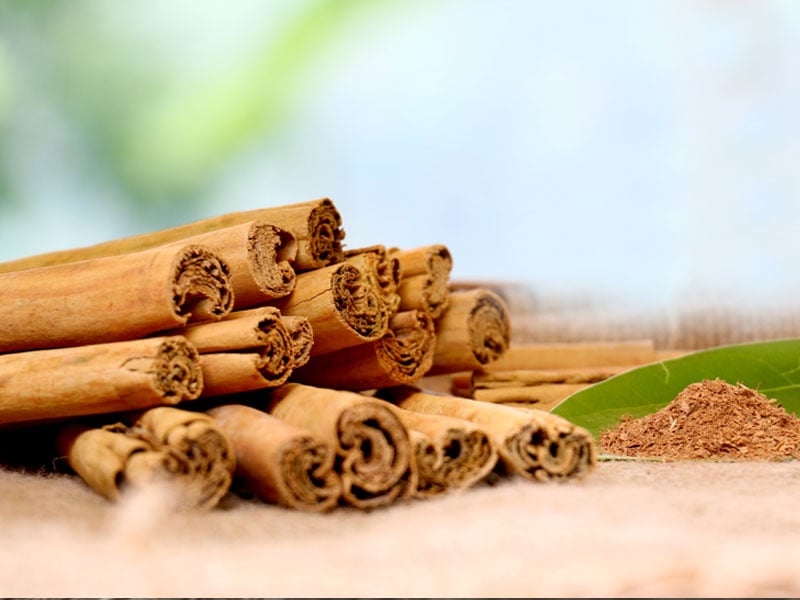
While you probably have tasted Cassia cinnamon at least once in your life, it’s a bit harder to stumble on Ceylon cinnamon, as it is a high-quality, top-tier spice. A bag of Ceylon cinnamon can cost 10 times as much as a bag of Cassia Cinnamon.
Ceylon cinnamon is grown in Sri Lanka and the southern provinces of India. Europe is the biggest market for this type.
Its flavor and color are lighter than its brother spice, possessing a light, tan-brown color and delivering a mildly sweet and delicate flavor. Ceylon sticks are often tightly packed with many thin, papery layers.
As it has a softer texture, you can easily break Ceylon cinnamon down and grind it into powdered cinnamon.
Ceylon cinnamon’s essential oil does contain cinnamaldehyde, albeit with a much lesser percentage at about 50 – 63%, which is why its flavor is milder. (2)
This is why Ceylon cinnamon is the superior cinnamon.
Health Benefits
Besides being a delicious spice, cinnamon has a multitude of health benefits. Even just a small pinch of cinnamon per day can improve your health in various ways. Here are some of the most prominent health benefits of cinnamon (3):
- Reduces cholesterol level: While you can’t really use cinnamon as a treatment for high cholesterol, consuming cinnamon daily can increase “good” cholesterol and decrease “bad” cholesterol levels.
- Reduces blood pressure: Regular consumption of cinnamon can reduce blood pressure by about 5 points.
- Reduces inflammation: Cinnamon’s antioxidant components have anti-inflammatory effects, which can fight inflammation.
- Speeds up metabolism: Cinnamon can affect fat cells to burn more energy, which is extremely useful for those trying to lose weight.
- Reduces risks of cancer: Studies have shown cinnamon’s promising ability to possibly slow down or even cure cancer cells.
- Resists bacteria: Cinnamon fights the bad types of bacteria that can cause damage to your health.
Cinnamon can do wonders to your health – the doctors say so!
Forms
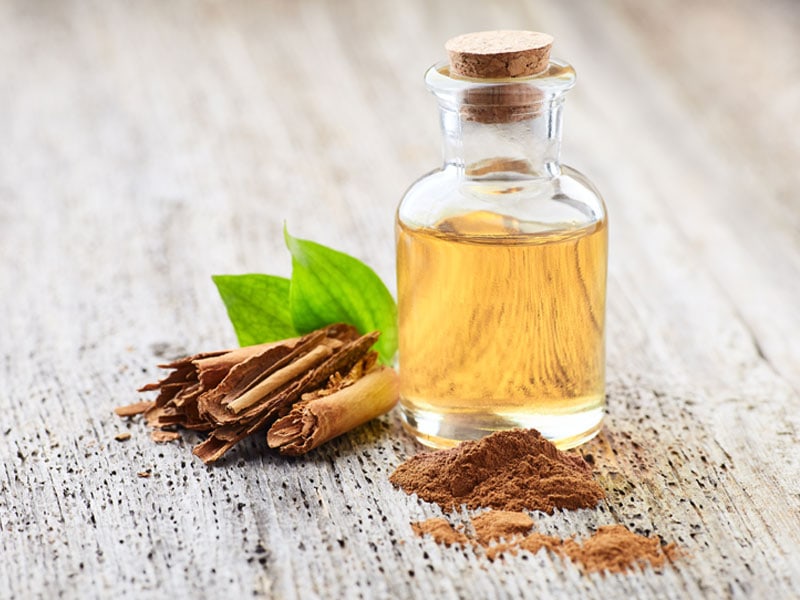
Cinnamon has been around for quite a long time and is also a beloved spice globally, so it’s only natural that it’s available in various forms for different uses. Three common commercial forms of cinnamon are cinnamon sticks, ground cinnamon, and cinnamon oil.
Before you read the details, here’s a table summarizing the differences between cinnamon sticks, ground cinnamon, and cinnamon oil.
Cinnamon Sticks
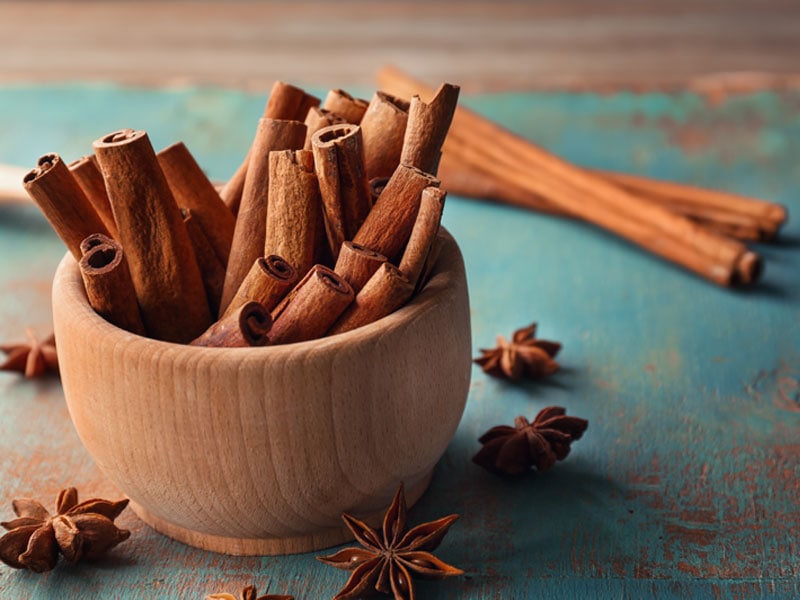
As the name suggests, cinnamon sticks have long, cylindrical shapes, with color and texture depending on the type of cinnamon.
However, cinnamon sticks are usually the Cassia type, as Ceylon cinnamon is quite soft and, therefore, can break down into smaller pieces before rolling into sticks.
Cinnamon in this form often appears in liquid beverages, as well as creams and stocks. You should also use cinnamon sticks in foods that have liquid, like curry or stews, or foods that cook for a long time, as cinnamon sticks can retain potency longer.
Cinnamon sticks can last up to 2 years when stored in ideal conditions.
Ground Cinnamon
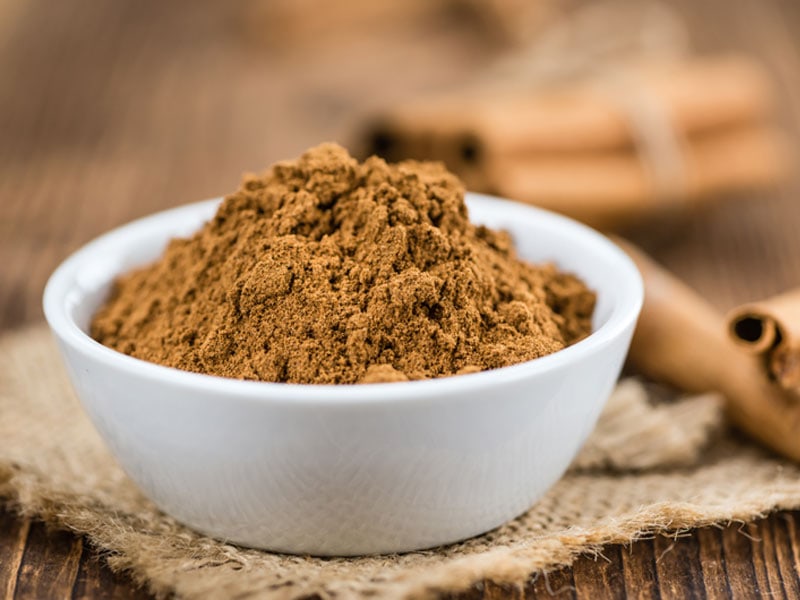
Ground cinnamon is simply cinnamon that is finely ground into grains. Ground cinnamon tends to add a stronger flavor than cinnamon sticks at first, as it has greater surface exposure and diffuses the flavor much more quickly.
However, due to the same reason, ground cinnamon loses flavor more easily and quickly than its firmer counterparts.
Ground cinnamon should last for about 6 months if you store it correctly. This is also due to greater surface exposure.
Ground cinnamon is great in bread, pastries, and dishes where it would be impractical to use and remove cinnamon sticks.
Cinnamon Oil
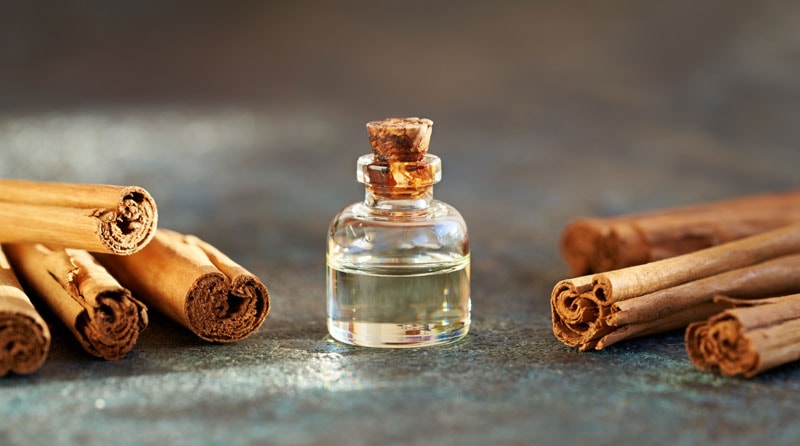
Cinnamon oil is extracted straight from cinnamon leaves or barks and condensed into oil, so it’s only natural that this form has the strongest flavor out of the three. It also lasts longer, as, under ideal preservation, one bottle of cinnamon can maintain its peak quality for 3 – 4 years.
As cinnamon oil is so strong, it’s rather hard for inexperienced home cooks to use it correctly, especially on first tries. It can take quite a process of trials and failures to arrive at the best proportion of cinnamon oil you need to use for each dish. Cinnamon oil is popular in liquid beverages like tea or coffee.
Can Cinnamon Dissolve?
The short answer: No.
The longer answer: Absolutely not.
One thing you need to understand is that, unlike other seasonings like sugar or ground pepper, cinnamon comes from tree bark. It is very fibrous as it comes from trees, so instead of dissolving in water, it absorbs water.
Trying to dissolve cinnamon is like trying to soak a wooden stick in water and hoping that it melts. The wooden stick will absorb water, but it won’t dissolve. You can wait for the stick to decompose, but I assume no one wants to wait a few hundred years for a drink.
What Happens When Cinnamon Is Soaked In Water
However, there’s one thing you need to take note of when you put cinnamon in liquid: The fibers in cinnamon will absorb moisture, so cinnamon will expand in water and turn slimy.
This is the reason why you can’t just put cinnamon grounds in your espresso coffee maker, as it can cause clogging or leave behind a frustrating amount of slimy sludge for you to clean up.
How To Add Cinnamon To Drinks
Cinnamon-infused drinks are the absolute essentials for colder seasons, but there are no rule books on when to drink something. If you have some cinnamon on hand and want a spicy, tasty drink, scroll down for instructions to make the best cinnamon drinks.
Use Cinnamon Sticks
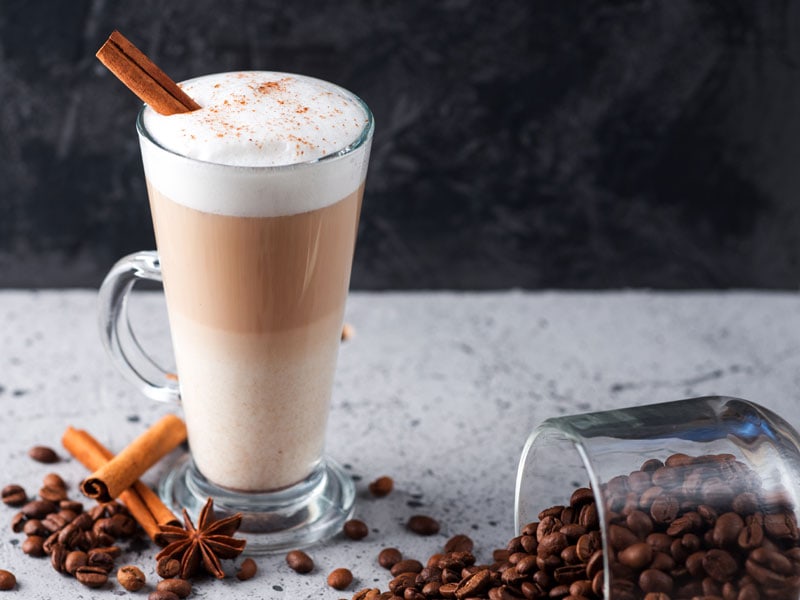
The easiest and most convenient way to enjoy cinnamon in drinks is to use cinnamon sticks to stir your drinks.
Cinnamon sticks pack a strong, intrusive flavor, so when you dip one into your drink, the flavor will seep out and infuse the drink. They tend to have a more robust, vivid flavor than ground cinnamon and won’t leave behind clumps to ruin your drinking experience.
One downside of cinnamon sticks is that every stick is single-use. This means when you have used one, you have to throw it away. So, use cinnamon sticks economically, everyone!
Use Cinnamon Sugar Syrup
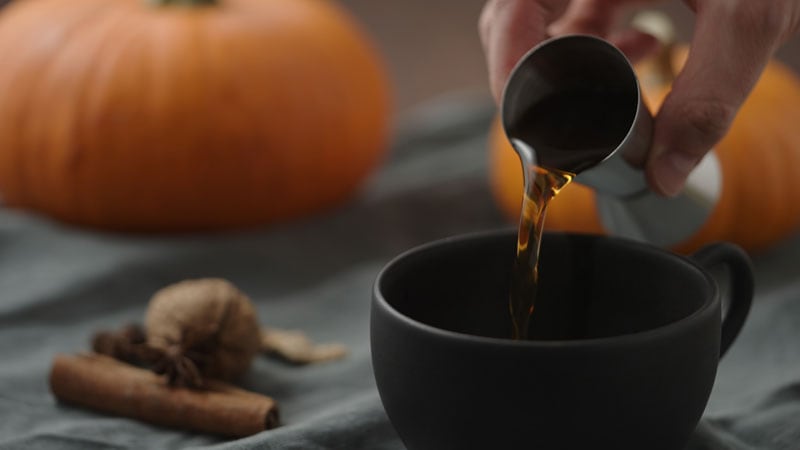
Cinnamon syrup is made by infusing cinnamon sticks into honey. It is a brilliant and convenient way to add both cinnamon and honey flavors to your drinks.
You can directly mix cinnamon with syrup or honey and add it to your drink. A good ratio is ½ teaspoon of cinnamon for every teaspoon of syrup or honey.
Stir this mixture well with a small amount of liquid first. Then, gradually pour in the rest of the drink, stirring continually.
Alternatively, you can make a bottle of homemade cinnamon syrup to use every time you need cinnamon. To make cinnamon syrup, follow these simple steps:
- Step 1: Break the cinnamon into smaller pieces and boil the cinnamon along with sugar and water. You should use 3 sticks of cinnamon for ½ cup of water.
- Step 2: Constantly stir the mixture to prevent burning. Wait until it has boiled for 2 – 3 minutes.
- Step 3: Remove the mixture from heat, close the lid of the pot/pan, and let it sit for 4 hours.
- Step 4: Filter the syrup by pouring it through a sieve and into a sealable jar.
When preserved in the correct conditions, a bottle of homemade cinnamon syrup can last up to 2 months.
Cinnamon sugar syrup is great for cinnamon fans with a sweet tooth. It is also convenient, as you only need to drop it in coffee without straining the clump or adding more sugar or honey every time you need a drink.
Use Cinnamon Oil
If you think cinnamon sticks are strong, cinnamon oil is much, much stronger. It is made by extracting the oil straight from cinnamon leaves or barks, so its flavor is highly concentrated.
And because it’s that strong, just an extra tiny droplet of cinnamon oil can upset the entire flavor balance of whatever dish or drink you’re making. So remember to proceed with caution.
One upside of using cinnamon oil is that as it is the essence of cinnamon flavor, it’s super flavorful and effective and adds a wonderful taste when used correctly.
To use cinnamon oil, you only need to follow 2 simple steps:
- Step 1: Use a clean toothpick to dip slightly into cinnamon oil.
- Step 2: Dip the toothpick into your drink.
And there you have it, a perfect cinnamon-infused drink.
Put Cinnamon In Water
People talk all day about cinnamon coffee, cinnamon cocktails, and whatnot, but what if you just want a plain ol’ cup of water? Well, grab your pen as I’m going to show you that making cinnamon water is as easy as it gets:
- Step 1: Boil water. Remember, boil only as much as you’ll need.
- Step 2: Remove the water from the heat and add in ground cinnamon. One cup of water should need about half a teaspoon of cinnamon.
- Step 3: Stir and close the lid of the pot/ container. Let the mixture sit until it cools.
- Step 4: Run the mixture through a mesh strainer to remove cinnamon particles.
- Step 5: Add other ingredients to your liking for flavor. You can use honey, apple slices, orange slices, etc. Stir well.
Put Cinnamon In Milk
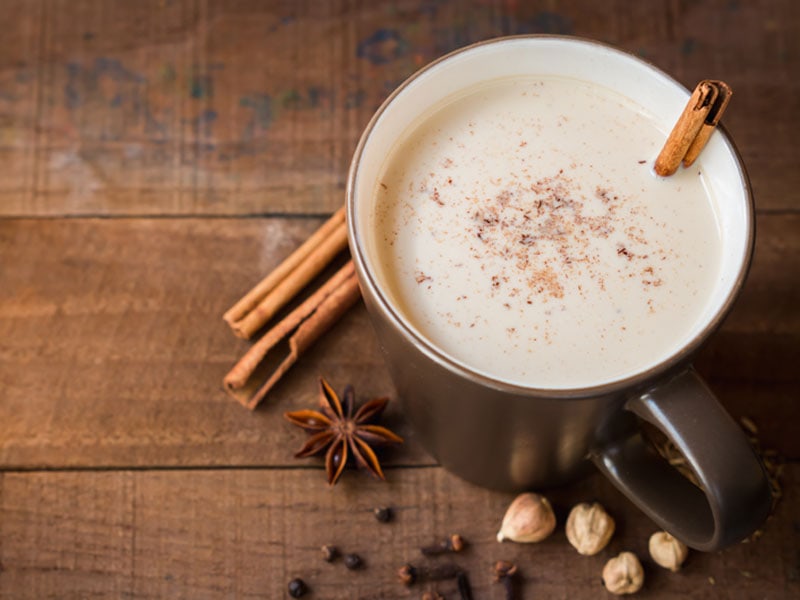
Cinnamon is spicy, and milk is sweet. It is destined in the stars that these two flavors can work perfectly with each other, and together they create the ultimate bedtime (or morning) drink that nothing can beat.
So how do you put cinnamon in milk the correct way? Let me show you:
- Step 1: Boil some milk. Remember, boil only as much as you will need.
- Step 2 (optional): Mix syrups or honey with cinnamon for flavor. It’s important to do this before adding them to milk to prevent clumping in the drink. One cup of milk should need about a teaspoon of ground cinnamon.
- Step 3: Remove the milk from the heat. Add in the syrup – cinnamon mixture, or just cinnamon if you don’t want anything else in your milk.
This is how you make the perfect cinnamon-infused milk.
Add Cinnamon To The Cream
If you drink coffee with cream, adding cinnamon to the cream before mixing them all in coffee is also a great idea.
To add cinnamon to creamed coffee, follow these simple steps:
- Step 1: Take a pinch of ground cinnamon and mix it in with the cream. In this case, it would be preferable to use heavy creams with a high fat level.
- Step 2: Add the mixture of cinnamon and cream to the coffee. Stir to blend.
This method will help the cinnamon grounds actually mix well with the coffee instead of collecting at the top.
Keep Cinnamon Sticks With Coffee Grounds
This works on a simple principle: Coffee grounds/ beans tend to absorb smells, so if you put cinnamon in coffee grounds, you can infuse them with the cinnamon aroma. When you use these coffee beans or grounds to make coffee, you will have cinnamon-flavored coffee.
The exact amount of cinnamon you need to put in depends on several factors: The amount of coffee you have; the absorption pace of the beans (differs from type to type); the length of time you keep cinnamon with coffee; and how strong you want the cinnamon smell to be.
One perk of this method is that you will have wonderful, aromatic cinnamon-flavored coffee without having to get rid of clumps. However, you will need to experiment quite a bit to work out how much and how long you need to put cinnamon sticks in.
Put Ground Cinnamon Into Coffee Grounds

Some might wonder if you can do the same trick with coffee grounds or coffee beans: Mix ground cinnamon with coffee grounds and wait for the aroma to stick. The answer is yes. The coffee will catch the aroma, but it will also create another set of problems.
As I have said before, cinnamon expands differently than coffee grains, so if you put cinnamon in an espresso machine, it will absorb the majority of the water, leaving your coffee ground untouched.
You will end up with a slimy mixture and an annoying amount of sludge to clean up from your machine.
However, you can put cinnamon along with coffee grounds into, say, filter coffee, a French press, or Turkish-style coffee. You would still have to run the coffee through a mesh strainer to get rid of cinnamon particles afterward.
Lastly, remember to use cinnamon wisely and not overdo it. The advised amount of cinnamon per cup of coffee is ¼ teaspoon, but you can adjust it based on your preference.
Great Cinnamon Alternatives You Should Know
If you can’t find any cinnamon available or simply want a new, refreshing twist to your normal food and beverages, there are several options to replace cinnamon. In this section, I will give you a brief description of some of the best substitutes for cinnamon.
Pumpkin Pie Spice Mix
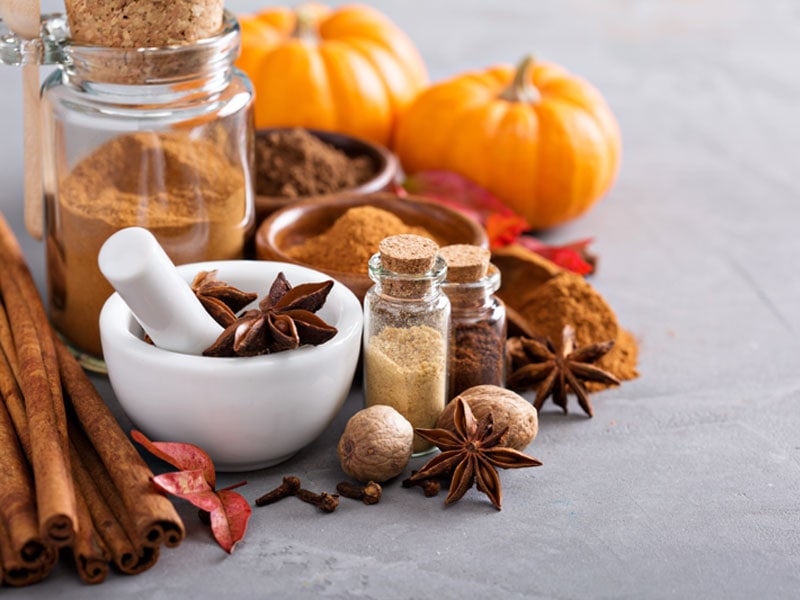
As the name suggests, the pumpkin spice mix is a ground mixture of different spices like cinnamon, nutmeg, cloves, ginger, and allspice and is used to season pumpkin pies.
Most of the pumpkin spice mix ingredients are cinnamon anyway, so if you don’t have cinnamon on hand, it is a great alternative. It also has the addition of other spices, which can be a perk for some and a downside for others.
Pumpkin Syrup
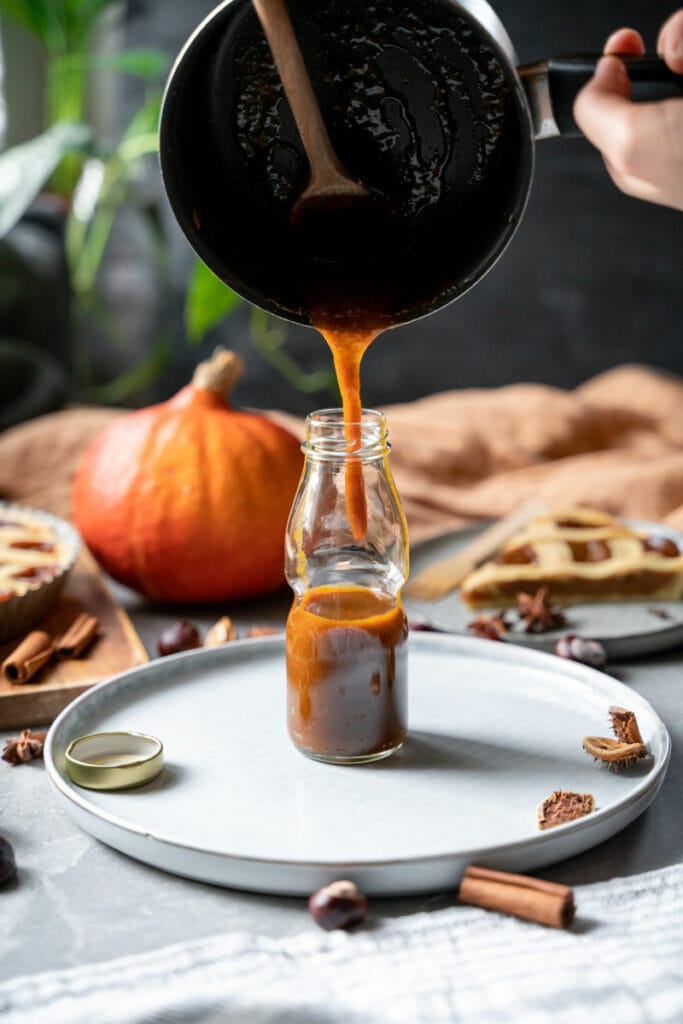
What if you want that pumpkin latte and can’t find a suitable substitute? Try pumpkin syrup.
It is made of virtually the same spices in pumpkin pie spice mix but with the added flavor of pumpkin.
The result is a warm, creamy, decadent thick liquid that you can either put in your drinks or pour on top of pastries like waffles and bread.
Ginger
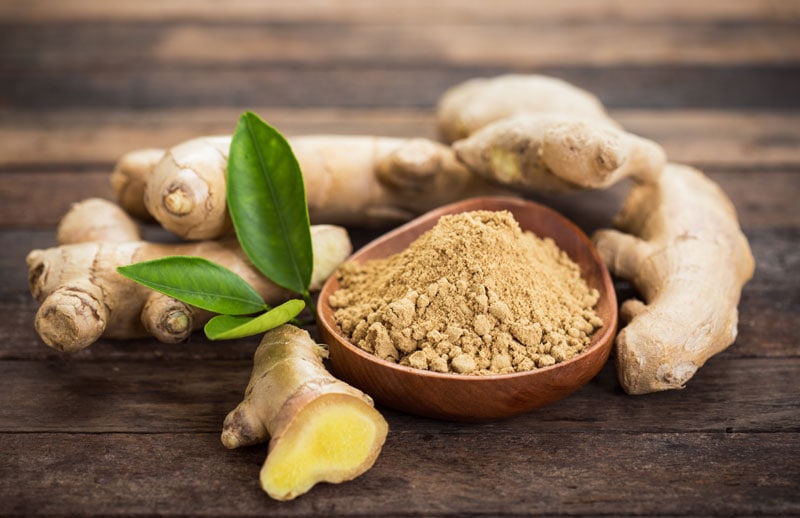
Having thousands of years of history, ginger is pretty much a kitchen staple worldwide at this point. It has a powerful spicy, zesty flavor, yet it also brings a tinge of sweetness to the taste.
Ginger has a distinct aroma, so you should make sure that the audience likes that aroma before incorporating it into dishes. When you decide to switch cinnamon to ground ginger, use it with the 1:1 ratio.
Cinnamon Sugar
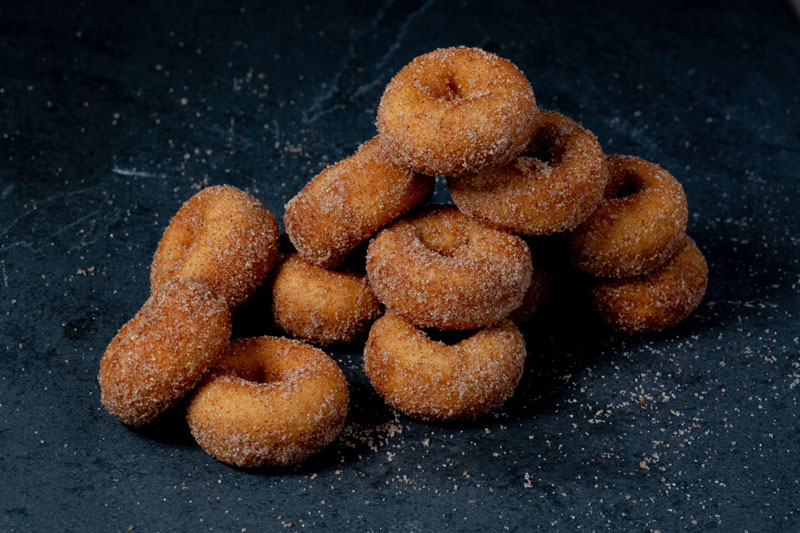
If you like cinnamon but also have a sweet tooth, cinnamon sugar is a great upgrade!
Cinnamon sugar is simply a blend of ground cinnamon and sugar, ground and whisked to mix. It has both the spicy flavor of cinnamon and the sweetness of sugar, and if you make it at home, you can easily control the ratio of each flavor.
Cinnamon is a brilliant addition to desserts – you can sprinkle it on donuts, toast, or hot cross buns, and it will elevate the dishes to a whole new level.
Nutmeg
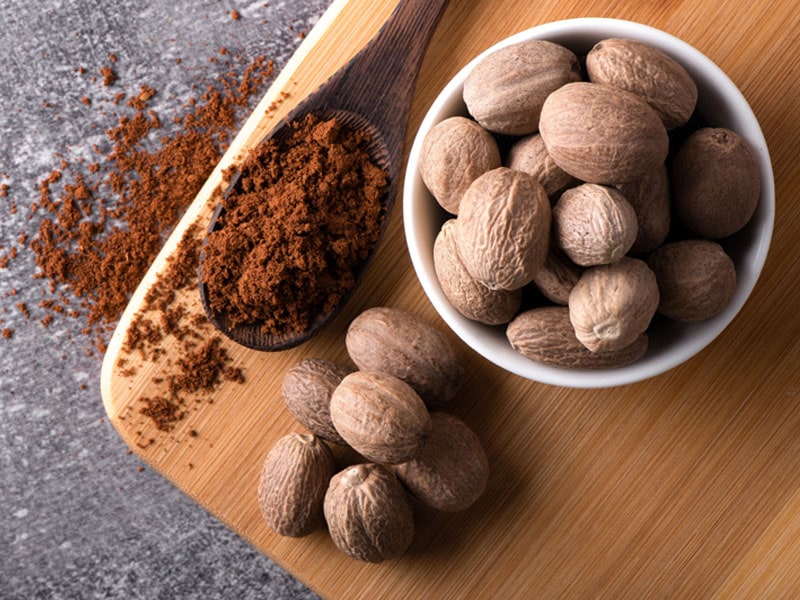
Nutmeg is quite close to cinnamon in terms of flavor. It is spicy, although with an earthy and nutty undertone.
Nutmeg also possesses some similar health benefits to cinnamon, like antioxidant and anti-inflammatory properties.
It is recommended that you use ground nutmeg in half or even a quarter of the amount you’d use cinnamon, as its taste is quite strong.
Delicious Food With Cinnamon To Try
Cinnamon has long been incorporated into a never-ending list of food. Its herbal aroma and spicy, bold flavor can bring some interesting twists to your dinner table. So what are the dishes you can make with cinnamon? Let’s find out!
Cinnamon Rolls
Cinnamon rolls are so popular that most people have tasted them at least once in their life. They are warm, fluffy, and hearty in a way that is so hard to resist. And they are so easy to make! If you have a sweet tooth, why not have a go at this wonderful but brilliant dessert?
Cinnamon Fried Apple
Being an amazing combination between cinnamon and apple, cinnamon fried apple is sweet and tart with a tinge of spice. This dish is great by itself as a dessert or a side dish as part of a traditional southern breakfast.
Baked Cinnamon Oatmeal
To all health enthusiasts, this is the perfect recipe for you! It’s vegan and gluten-free, yet it is still delicious and nutritional. The combination of gluten-free baked oatmeal, vanilla, apple sauce, and cinnamon creates an intriguing flavor you won’t forget.
Check Out These Tasty Drinks With Cinnamon
No one knows who first thought to put cinnamon in drinks and why they did it, but I can be sure that cinnamon in drinks is a brilliant idea. A discovery, an invention, even. Cinnamon works magic with any drink, and I am going to show you some of the best combinations.
Cinnamon Tea
There is something about the word “cinnamon tea” that screams “autumn” to me, and I think you will agree. Imagine wrapping yourself in a warm blanket, immersed in a book, and sipping a cup of cinnamon tea as autumn winds swirl outside your door. Heaven!
Cinnamon Milk
If you are experiencing mild insomnia or restlessness, maybe a cup of cinnamon milk can help. The heat of warm milk and honey will help you relax, and the herbal aroma and properties of cinnamon will do wonders for your health.
Cinnamon Latte
Not a fan of warm drinks? Try making this iced latte instead. It only takes a few minutes but is a wonderful addition to your breakfast if you are a coffee person. And who wouldn’t want a little taste of cinnamon before they start their day?
FAQs
While the information above can cover pretty much all bases, you might still have some questions. In this section, I’m going to address some of the most commonly asked problems regarding cinnamon.
It’s High Time You Grab Some Cinnamon!
For the inexperienced, cinnamon can be a bit complicated. But when you’ve understood the basics, it will be much easier to navigate the world of cinnamon. It only takes a bit of time, some effort, and experimentation. How hard can it be?
Ladies and gentlemen, I will wrap up the post here. If you have any questions or additional tips and tricks to use cinnamon, you can comment below to share it with others. And if there’s someone else who might need this, don’t forget to send it to them!
References
- Cinnamon (2022) Wikipedia. Wikimedia Foundation.
- Leech, J. (2016) Ceylon vs. cassia – not all cinnamon is created equal, Healthline. Healthline Media.
- Cinnamon Health Benefits (no date) WebMD. WebMD.

